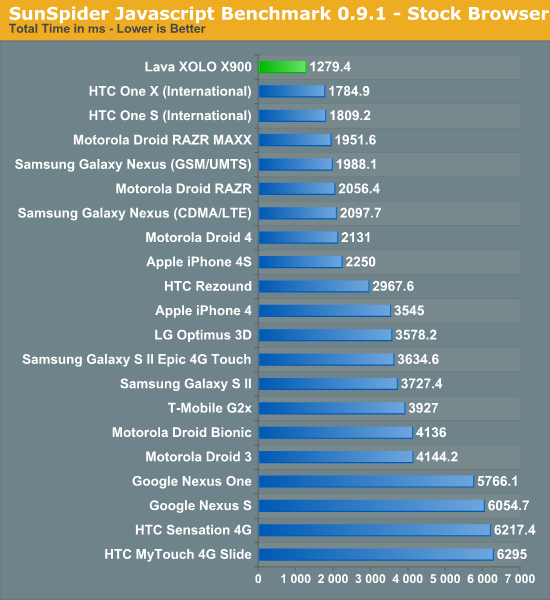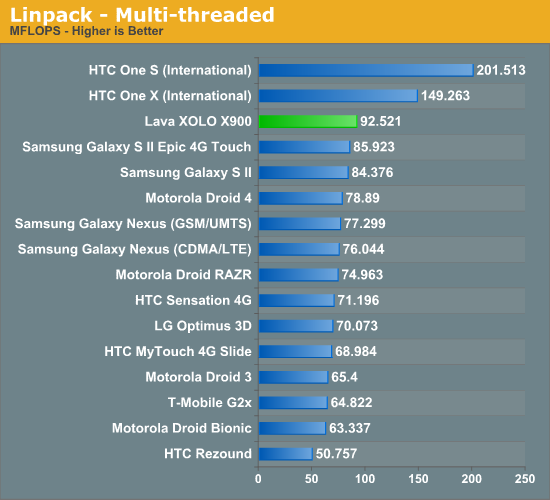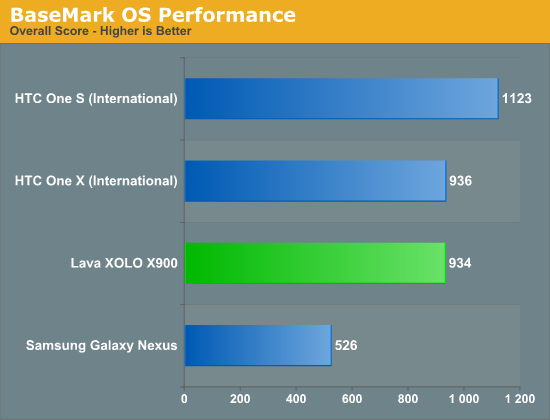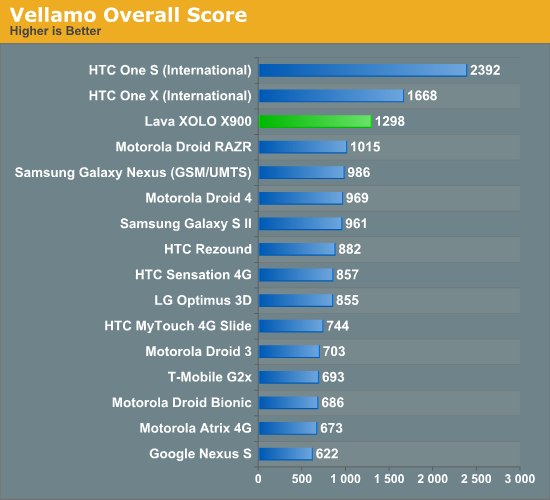Lava Xolo X900 Review - The First Intel Medfield Phone
by Brian Klug on April 25, 2012 6:00 AM ESTJavascript Performance
Although smartphones are clearly headed for a life beyond simple messaging, web browsing and phone duties, we are still lacking the tools to measure performance in areas other than a component of web page rendering. Measuring javascript performance is one component of the entire web page rendering process but it's the most mature in terms of something we can benchmark.
Sunspider is quite possibly the most well known of these javascript tests, and it also happens to be one that runs extremely well on Medfield:

The Lava phone is just a tad faster than the FFRD we tested at the beginning of the year, which may not sound like much but is positive given that Mike Bell was very confident that all Intel FFRD phones would deliver the same level of performance. The X900 ends up being the fastest smartphone we've ever tested here. Intel won't be able to claim that title in any other benchmark here today but it's an impressive feat for just now showing up to the game. It's also worth pointing out that Intel is able to do this well running on Gingerbread, while its closest competition are running on Ice Cream Sandwich with far improved JS performance built into the browser.
Why is Medfield so much faster here? It's tough to say, but likely a combination of reasons. Google's V8 engine has had a ton of optimization work done around x86 to begin with. By virtue of nearly every computing platform that runs a Google browser outside of Android being x86, it's natural that some of those optimizations are going to transition over into Android for x86 as well. That's actually a part of a much larger advantage Intel has should x86 take off in the smartphone space.
On a more technical hardware level, Intel claims its cache and memory interfaces are simply better than the competition here - which in turn results in a significant performance jump in Sunspider.
BrowserMark is another js benchmark in our suite, but here the advantage has been reduced to simply competitive with the fastest phones in our labs:

For a single Atom core running Gingerbread, Medfield does very well here - roughly equaling the performance of NVIDIA's Tegra 3 (HTC One X) and Qualcomm's Snapdragon S4 (HTC One S). It's quite possible that when running ICS Medfield will once again step ahead of the competition, but even if this is as good as it gets it's a good start. Keep in mind that we're looking at a 4 year old microprocessor architecture running on a n - 1 process from Intel.
Low Level FP Performance
Linpack isn't a great indication of smartphone performance, but it is a good test of the floating point capabilities of the CPUs in these SoCs. ARM has steadily been improving FP performance for the past few generations but we're going to see a big jump to Krait/A15. As most client smartphone workloads are integer based and those that are FP heavy end up relying on the GPU, an advantage here doesn't tell us much today (particularly because Linpack isn't running native code but rather atop Dalvik) other than how speedy the FPUs are:

Single threaded FP performance is very good on Medfield as you'd expect, but a bit lower than Qualcomm's Snapdragon S4. As Krait is a wider, out-of-order architecture with a fairly reasonable FPU the 13% advantage here isn't too surprising. Compared to anything A9 based however, Medfield is obviously quicker.
Linpack, like many scientific workloads, scales up to multiple cores quite nicely. If we spawn as many threads as there are logical cores (2 for Intel and Qualcomm, but 4 for NVIDIA's Tegra 3) we can see how Intel's single-core Atom fares in a multithreaded world:

There's roughly no change in Medfield's performance here, which will be an issue for any compute heavy, very threaded application. Luckily for Intel, not many of these types of applications exist on smartphones today, but it is a limitation of this first generation Medfield. Hyper Threading is a great way to increase CPU utilization power efficiently, but for some workloads there's no replacement for more cores. Snapdragon S4 does extremely well here in the HTC One S by being a combination of two cores and having a much faster FPU.
BaseMark OS
Rightware's BaseMark OS is a general purpose benchmark designed to better simulate overall Android performance. It includes a heavily threaded benchmark, file IO tests, and compression/decompression tasks that all contribute to its overall score. We only have results from the HTC One S (Snapdragon S4), One X (Tegra 3), Galaxy Nexus (OMAP 4) and the Lava phone (Medfield) here:

At least in BaseMark OS, Intel's performance is distinctly modern although not at the head of the class. Differences in performance here extend beyond the SoC and are obviously influenced by things like NAND selection as well as the OS on the device. For many of these benchmarks I'm very curious to see how they change with the arrival of Ice Cream Sandwich.
Vellamo
Vellamo is a Qualcomm developed benchmark that focuses primarily on browser performance, both in rendering and UI speed. The results are heavily influenced by the browser used on the device being tested. As a whole Vellamo isn't always indicative of whether or not you're going to get a smooth browsing experience, but it's another datapoint that captures more than just javascript performance. The Qualcomm-developed nature of the benchmark is always cause for concern, but even if you exclude the Snapdragon results the benchmark can be useful:

Once again we have a good showing from Intel. The X900 and its Medfield soul aren't the fastest, but Intel's first smartphone is in the top three and faster than almost everything that came before it. Much of the advantage here actually comes from the Google V8 benchmark, another js test, which we've already established Intel can do quite well in.
Flash Rendering Performance
These days nearly all high-end smartphones (I refuse to call them superphones) can render Flash smoothly. Thankfully Intel's platform is no exception as the X900 delivers a competitive showing in our Flash benchmark:











106 Comments
View All Comments
superPC - Thursday, April 26, 2012 - link
Well this atom only has 1/4 of conroe dual core transistor count right now. a move to 22nm could bring conroe level performance.Khato - Thursday, April 26, 2012 - link
Remember, conroe class performance simply indicates a general IPC level. I don't expect something on par with an E8600, more like a SU9600. It's quite feasible on the 22nm LP process, and actually is roughly in-line with the one Atom performance roadmap from awhile ago.extide - Wednesday, April 25, 2012 - link
That wont be happening for a while, but from what I have heard 2013 will bring us a second gen (out-of-order) atom on a mature 22nm process. We should see 2Ghz+ clockspeeds and 2 cores, plus a healthy IPC boost. This is going to be an exciting battle to watch, the old Intel vs AMD gig is kind of stale, so its awesome to see a real challenge for Intel again!A5 - Wednesday, April 25, 2012 - link
ULV Haswell will have a TDP an order of magnitude too high for a phone form factor. Tablets, maybe.MonkeyPaw - Wednesday, April 25, 2012 - link
"We waited years for Intel's first smartphone, now the question is how long do we have to wait for the first irresistable one?"It wont matter. Intel will dump millions into advertising, and every single phone maker will have ads for their new x86 phones, ending with the usual Intel chorus.
dougys - Wednesday, April 25, 2012 - link
I read somewhere else a few weeks back that the iPhone 5 could have Intel Inside. However, something else I read suggested that if they were to do this all the apps would have to be re-written... Does anyone have any thoughts/insight?tipoo - Wednesday, April 25, 2012 - link
Apple has a few architecture changes under its belt, but I very much doubt it, not for this chip. Apple bought chip design companies and spends more on internal chip design year after year for good reason.Not sure about iOS compatibility but this chip can run any Android apps just fine as the article points out through binary translation, I think Android apps use Java and iOS uses C++ though so I'm not sure if that would still work.
If Apple was to go to an outside design for its chips (which I highly doubt it will) I'd hope it would be for Qualcomm, Krait is amazing.
dcollins - Wednesday, April 25, 2012 - link
Apple will not move to an Intel chip anytime soon because they have been very successful in designing their own SoC. Just look at the battery life benchmarks: Apple crushes everyone in Hours/Watt*Hour. Plus, doing it in house gives them more flexibility on the overall design of their boards.There is a small chance of Intel manufacturing chips for Apple, but that is a long shot as well. Chips manufactured on Intel's 22nm 3d gate process would be incompatible with chips produced on competing 28nm processes (different physical size) and Apple is traditionally opposed to single sourcing crucial components.
tipoo - Wednesday, April 25, 2012 - link
Why does the GN get worse flash performance than the Nexus S and even Nexus One? That isn't a resolution dependant test, right?I'm also curious why the dual core Atrix barely does better than the single core Nexus S in Vellamo, was that just a bad SoC design or is it because it runs an older OS?
tipoo - Wednesday, April 25, 2012 - link
I also just got 915 on my Nexus S rather than 622, but I'm using an unofficial Cyanogenmod 9 build from XDA forums.